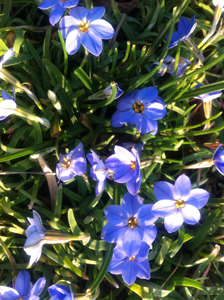Resource Library
Plant of the Week: Springstar. Rolf Fiedler
The University of Arkansas System Division of Agriculture does not promote, support or recommend plants featured in "Plant of the Week." Please consult your local Extension office for plants suitable for your region.
Plant of the Week
Rolf Fiedler Springstar
Latin: Ipheion uniflorum ‘Rolf Fiedler’

My garden, like most, has an international flavor. Much of it is comprised of plants from the Northern Hemisphere, but occasionally a few species from south of the equator slip in to provide a down-under perspective. One of my favorite springtime bulbs is Rolf Fiedler springstar (Ipheion uniflorum ‘Rolf Fiedler’), a bulb from southern South America.
Ipheion uniflorum is one of a dozen species of bulbous plants of the onion family that are distributed in Uruguay, southern Brazil, Argentina and Chile. Most species are alpine plants of the Andes or, as in the case of this species, widely distributed in rolling foothill habitats. This species grows about six inches tall when in bloom with inch-wide, six-petaled, star-shaped blooms in shades of white, pale blue, or in the case of ‘Rolf Fiedler’, light gentian blue. Though only one bloom is produced per scape, each bulb produces multiple scapes over about a six-week period, so plants remain effective over a longer period in the spring than most other bulbs.
The bulbs are fleshy, bullet-shaped and about the size of the end of your thumb. They produce offsets freely, and quickly naturalize in the area planted. Leaves are about a quarter of an inch wide and 4 inches long, and lay close to the ground. They appear in late fall and persist through the winter, smell of garlic when crushed and disappear with the droughts of summer.
Botanists have had more than a little confusion about what to call this plant, and how to classify it and its relatives. The genus Tristagma is used by the USDA to describe this plant. The latest thinking, based on DNA work, seems to be to retain the name Ipheion, but no doubt the name-change game will continue well into the future. ‘Rolf Fiedler’ appeared in the middle years of the 20th century (it was officially registered in 1983), apparently given to its namesake at an international plant conference. This cultivar may not belong to this genus, but because I. uniflorum is the most widely cultivated of the genera, it is often listed here.
For being a South American bulb, springstar is surprisingly winter hardy. It grows throughout zone 5, but is probably more at home in warmer climes. It will reseed, and is considered an escaped plant by the USDA, with naturalized stands found in the southeastern states, from the Carolinas to Texas and California and Oregon. Because it has been long cultivated in Southern gardens, it qualifies as an heirloom plant.
Ipheion is ideally suited for use in the rock garden or front-of-the-border plantings. It has the same size and stature of crocus, so it can be used in any situation where this more common spring-bloomer can be grown, including naturalized in lawns. Plant it in full sun to very light shade for best results. It has considerable drought tolerance but also seems to benefit from summertime moisture, as long as the site is well-drained. Though it will reseed, it is not aggressive about it, and no one seems find the appearance of additional plants problematic.
By: Gerald Klingaman, retired
Retired Extension Horticulturist - Ornamentals
Extension News - March 23, 2012
The University of Arkansas System Division of Agriculture does not maintain lists of retail outlets where these plants can be purchased. Please check your local nursery or other retail outlets to ask about the availability of these plants for your growing area.